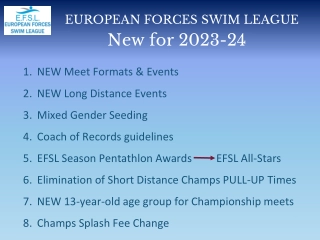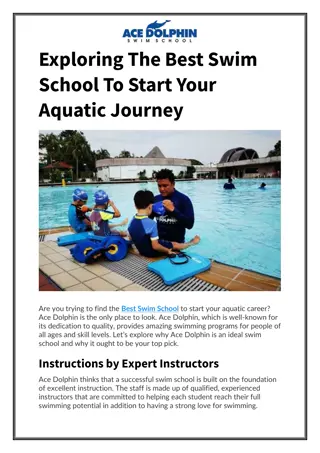Surviving Your Child's First Swim Season: A Guide for Parents
Welcome to the exciting journey of being a swim parent! Learn about the benefits of swimming, the role parents play in their child's success, and why swimming is a fantastic activity for children of all ages. Discover key tips on how to be a positive role model, promote sportsmanship, and encourage self-improvement in your young swimmer. Find out how swimming fosters physical fitness, mental well-being, and important life skills such as time management and goal orientation.
Download Presentation

Please find below an Image/Link to download the presentation.
The content on the website is provided AS IS for your information and personal use only. It may not be sold, licensed, or shared on other websites without obtaining consent from the author.If you encounter any issues during the download, it is possible that the publisher has removed the file from their server.
You are allowed to download the files provided on this website for personal or commercial use, subject to the condition that they are used lawfully. All files are the property of their respective owners.
The content on the website is provided AS IS for your information and personal use only. It may not be sold, licensed, or shared on other websites without obtaining consent from the author.
E N D
Presentation Transcript
New Swimmers Parent Orientation HOW TO SURVIVE YOUR FIRST AND EVERY SEASON
Welcome Welcome to the Green Family YMCA Barracudas Swim Team Introductions Objectives
CONGRATULATIONS, YOU ARE A SWIM PARENT Parents contribute to the success experienced by the child and the team. Parents serve as role models and their children emulate their attitudes. Be aware of this and strive to be positive role models. Most importantly, show good sportsmanship at all times toward coaches, officials, opponents and teammates. Remember that you are teaching your child at all times.
THE BENEFITS OF SWIMMING WHY SHOULD MY CHILD BE A SWIMMER? Swimming is an outstanding activity for people of all ages. Swimming promotes fitness and teaches a child to strive for physical achievement. Many super-stars in other sports started out as swimmers and gained strength and coordination that helped them to excel. Swimming is an exciting individual and team sport. Swimming is a technical and specialized activity involving extensive skill development.
THE BENEFITS OF SWIMMING Swimming is a healthy "lifetime" activity. Participants may be 1 or 101 years old. Swimming is relatively injury free in comparison to other youth sports. Swimming teaches the life lessons of sport and sportsmanship which include: learning to deal with winning and losing, as well as working with officials, teammates and coaches, and, while in school, time management. Swimming motivates participants to strive for self- improvement and teaches goal orientation. Swimming cultivates a positive mental attitude and high self- esteem.
THE BENEFITS OF SWIMMING DID YOU KNOW? There are many health benefits with swimming Swimming can prevent drowning. Drowning is a leading killer of American children. More than 30% of kids are at risk for obesity-related illnesses. Swimming is a cure for both of the above.
THE BENEFITS OF SWIMMING KEY QUESTIONS While winning is nice, while setting a record, getting a best time, or making a qualifying time feels good, we hope that our young athletes learn more than, It is great to swim fast. Nowhere in human history or theology do we learn that the ability to swim fast holds a very high priority in the grand scheme of the universe. From a practical standpoint, over-emphasis on speed, times and achievements will eventually end in frustration. No matter how fast a young athlete swims, there will probably be another swimmer in the next town, state, or country, swimming faster, if not now, then next month.
THE BENEFITS OF SWIMMING Coaches and parents should ask themselves: - Did the child learn to swim with more skill this past season so he or she is both stronger and safer in the water? - Did the child learn to exhibit initiative, wanting to come to the pool and do the practice without having to be constantly pushed or prodded by parents and coaches? - Did the child learn something about unselfishness, sacrificing his or her personal wants for the good of others or the team? - Did the child benefit from the competitive experience, learning how to handle winning and losing in our competitive society? - Did the child learn more patience in overcoming obstacles, setbacks and problems? - Did the child learn empathy? In a few years, the medals and ribbons will be laid aside and best times will be a hazy memory. The friendships that will develop and the life skills learned will carry on for a lifetime. Swimmers become an extended family and swimming a way of life.
THE FOUR STROKES The four competitive swimming strokes are freestyle, backstroke, breaststroke and butterfly. The combination of all four strokes is called individual medley. In freestyle events, the competitor may swim any stroke. The stroke most commonly used is sometimes called the crawl, which is characterized by the alternate stroking of the arms over the surface of the water surface and an alternating (up-and-down) flutter kick
THE FOUR STROKES Backstroke consists of an alternating motion of the arms with a flutter kick while on the back. On turns, swimmers may rotate to the stomach and perform a flip turn and some part of the swimmer must touch the wall. The swimmer must finish on the back.
THE FOUR STROKES The breaststroke requires simultaneous movements of the arms on the same horizontal plane. The hands are pressed out from in front of the breast in a heart shaped pattern and recovered under or on the surface of the water. The kick is a simultaneous somewhat circular motion similar to the action of a frog. On turns and at the finish, the swimmer must touch the wall with both hands simultaneously at, above or below the water surface.
THE FOUR STROKES Some consider the butterfly to be the most beautiful of the strokes. It features a simultaneous recovery of the arms over the water combined with an undulating dolphin kick. In the kick, the swimmer must keep both legs together and may not use flutter, scissors or the breaststroke kick. Both hands must touch the wall simultaneously on the turns and the finish.
THE FOUR STROKES The individual medley, commonly referred to as the I.M., features all four strokes. In the IM, the swimmer begins with the butterfly, then changes after one-fourth of the race to backstroke, then breaststroke and finally freestyle. For the I.M., during the freestyle leg, the swimmer must use a stroke other than backstroke, breaststroke or butterfly, and in a recent rule change, may not push off the wall on the back. The most commonly used stroke is the front crawl.
RULES PRIMER The technical rules of swimming are designed to provide fair and equitable conditions of competition and to promote uniformity in the sport. Each swimming stroke has specific rules designed to ensure that no swimmer gets an unfair competitive advantage over another swimmer
RULES PRIMER Trained officials observe the swimmers during each event to ensure compliance with these technical rules. If a swimmer commits an infraction of the rules that is observed by an official, a disqualification (DQ) will result. This means that the swimmer will not receive an official time and will not be eligible for an award in that event. A disqualification may result from actions such as not getting to the starting blocks on time, false starting, performing strokes in an illegal manner, or unsportsmanlike conduct.
RULES PRIMER DQs are also a result of technical rules violations. They include but are not limited to: Freestyle: Walking on the bottom, pulling on the lane rope, not touching the wall on a turn, or not completing the distance. Backstroke: Pulling or kicking into the wall once a swimmer has turned passed the vertical onto the breast. (this rule is different in high school competition) Turning onto the breast before touching the wall with the hand at the finish of the race.
RULES PRIMER Breaststroke: An illegal kick such as flutter (freestyle), dolphin (butterfly), or scissors (side stroke); not on the breast; alternating movements of the arms; taking two arm strokes or two leg kicks while the head is under water; touching with only one hand at the turns or finish. Butterfly: Alternating movements of the arms or legs; pushing the arms forward under instead of over the water surface (underwater recovery); a breaststroke style of kick; touching with only one hand at the turns or finish.
RULES PRIMER For specific language on any technical rules consult the USA Swimming Rules and Regulations book. Violations of the rules are reported to the Referee. The rules require that every reasonable effort be made to notify the swimmer or his coach of the reason for the disqualification. If your child is disqualified in an event, be supportive rather than critical. For beginning swimmers, a disqualification should be treated as a learning experience, not as a punishment. A disqualification alerts the swimmer and coach to what portions of the swimmer's stroke need to be corrected. They should be considered in the same light as an incorrect answer in schoolwork-they point out areas that need further practice. Disqualifications are necessary to keep the competition fair and equitable for all competitors. A supportive attitude on the part of the official, coach, and parent can make a positive situation out of the disqualification.
COMPETITION 101 COURSE Competition pools may be short course (25 yards or 25 meters), or long course (50 meters). The international standard (as used in the Olympics) is 50 meters. World records are accomplished in 25 and 50 meter pools. USA Swimming maintains records for 25 yard, 25 meter and 50 meter pools. Our pool is 25 yards and Ocasek Natatorium is 50 meters in the summer.
COMPETITION 101 COMPETITION Participants compete in different age groups and meets depending on their achievement level and how old they are on the first day of the meet. Y meets and the MOSL have cut off dates for a child s age for any particular season For the Y s winter season the date is December 1. For the MOSL, the date is June 1. All USA meets use the swimmer s age on the first day of the meet. Traditionally recognized age groups are 8 and under, 10 and under, 11-12, 13-14, 15-16, 17-18 and Open or Senior. There are several local meets feature 8 and under only, single age groups (11, 12, 13 etc.), or senior (also known as open) events. Often USA meets have cut-off times, either faster than or slower than. Team practice groups are usually determined by age, experience and/or ability.
COMPETITION 101 OFFICIALS Officials are present at all competitions to enforce the technical rules of swimming so the competition is fair and equitable. Officials attend clinics, pass a written test and work meets as a sort of apprentice before being certified. All parents are encouraged to get involved with some form of officiating A good way to start is to become a Y official and help with our home meets We also need help running stopwatches, the timing system and scoring computer.
Equipment MUST HAVES FOR THE NEW SWIMMER Goggles: Swimmers use goggles to protect their eyes from the chlorine as well as to gain a clear view of their surroundings in the pool. There are a variety of colors and styles depending on the preference of the swimmer. Goggles range from $6.50 $29.99. Caps: Caps are designed to keep the hair out of swimmers faces and goggles straps in place. Caps range from $3.99 - $19.99.
Equipment MUST HAVES FOR THE NEW SWIMMER Women s Practice Suit: Practice suits are used during workouts. They are created with a stronger material for durability. Some may create extra drag to make the workout more challenging. Women s practice suits range from $33.00 - $76.00. Men s Practice Suit: Practice suits are used during workouts. They are created with a stronger material for durability. Some may create extra drag to make the workout more challenging. Men s practice suits range from $22.00 - $47.00. Note: Clubs often arrange discounts with their local swimming apparel company. Please ask your coach regarding any team discount on equipment. The Parents Board will help you order the team suits and caps for use in meets.
Equipment ITEMS YOU MAY NEED Mesh Bag: A mesh bag is used by swimmers to hold their training equipment. Mesh bags range from $6.00 - $18.00. Kickboard: A kickboard is a floating device used by swimmers during practice to enhance their kicking skills. Kickboards range from $6.95 - $24.99. The Y provides these for practice. Pull Buoys: Pull-Buoys are a device used by swimmers during a practice to enhance body position during pull sets when the swimmers are not kicking. Pull buoys range from $6.95 $11.99.
Equipment ITEMS YOU MAY NEED Fins: Fins are a device that fit on a swimmers feet to increase kicking speed during practice. Fins range from $22.95 $45.95. Paddles: Paddles are a plastic device placed on a swimmers hands during practice. The paddles are used to add resistance to the pulling phase of the stroke. There are a variety of paddles available, depending on the stroke you are swimming and the purpose of the pulling drill. Paddles range from $7.95 - $21.00.
SWIM MEET BASICS Swim meets are a great family experience. They're a place where the whole family can spend time together. Listed below are some very in-depth guidelines geared to help you through your first couple of swim meets. It may seem a little overwhelming, but we tried to be as specific and as detailed as we possibly could. If you have any questions, please ask your coach.
SWIM MEET BASICS BEFORE THE MEET STARTS Arrive at the pool at least 15 minutes before the scheduled warm-up time begins. This time will be listed in the meet information emailed to all swimmers and also in the team website and Facebook page. Upon arrival, find a place to put your swimmer's blankets, swim bags and/or sleeping bags. The team usually sits in one place together, so look for some familiar faces.
SWIM MEET BASICS Find the check-in place. Usually, parents are not allowed on deck so this may be a responsibility of your swimmer or your swimmer s coach. Make sure your swimmer checks in with his or her coach! Check for special posted instructions in the check-in area. At USA meets, the swimmer's name or "# before each swimmer's name will need to circled, in each event he or she is swimming, that day. If this is not done, the swimmer will not be allowed to swim that event. Check-in is required so that the people running the meet know who is actually at the meet. After check-in, the meet administrators "seed" the swimmers into heats. Heat and lane assignments will be posted, so be sure your swimmer knows where to look!
SWIM MEET BASICS Sometimes the meet is "pre-seeded" and no check-in is required. You and your swimmer can find heat and lane assignments by purchasing a program. Once "checked in", write or have the swimmers write each event/heat/lane number on his or her hand in ink. This helps him/her remember what events he/she is swimming and what event number to listen or watch for. For our dual meets, this process is aided by our volunteer age group coordinators. Your swimmer now gets his/her cap and goggles and reports to the pool and/or coach for warm-up instructions. It is very important for all swimmers to warm-up with the team. A swimmer's body is just like a car on a cold day-he/she needs to get the engine going and warmed-up before he/she can go all out.
SWIM MEET BASICS After warm-up, your swimmer will go back to the area where his/her team is sitting and wait there until his first event is called. This is a good time to make sure he/she goes to the bathroom if necessary, gets a drink, or just gets settled in. The meet will usually start about 10-15 minutes after warm-ups are over. According to USA Swimming rules (because of insurance purposes), parents are not allowed on deck unless they are serving in an official capacity. Similarly, all questions concerning meet results, an officiating call, or the conduct of a meet, should be referred to a coach. He or she in turn, will pursue the matter through the proper channels.
SWIM MEET BASICS Psyche Sheet or Heat Sheets. For USA meets, a psyche sheet is usually available for sale in the lobby or concession area of the pool. It lists all swimmers in each event in order of "seed time". When the team entry is sent in, each swimmer and his/her previous best time (up to the date that the entry was submitted) in that event is listed. If the swimmer is swimming an event for the first time, he/she will be entered as a "no-time" or "NT". A "no-time" swimmer will most likely swim in one of the first heats of the event. A Heat sheet may be available close to the start of the meet that lists the actual heat and lane in. which a swimmer will be competing
SWIM MEET BASICS MEET STARTS It is important for any swimmer to know what event numbers he/she is swimming (again, why they should have the numbers on their hand). He/she may swim right away after warm-up or they may have to wait awhile.
SWIM MEET BASICS Most meets entries are computerized: Lanes and heats are assigned by the times submitted. For dual meets, each team is assigned certain lanes that they use throughout the meet, at least for the scoring heat. There are generally two ways a swimmer gets to his/her lane: A swimmer usually reports directly to his/her lane for competition a number of heats before he/she actually swims. Check with your swimmer's coach for specific instructions. In some novice meets, a swimmer's event number will be called, usually over the loudspeaker, and he/she will be asked to report to the "clerk of course" or bullpen where they will be organized into their proper heats and lanes. Swimmers should report with his/her cap and goggles.
SWIM MEET BASICS Generally, girls events are odd-numbered and boys events are even- numbered. Example: "Event #26, 10-Under Boys, 50 freestyle, report to Clerk of Course." The "Clerk of Course" or bullpen area is usually where all swimmers checked in before the warm- up. The clerk will usually line up all the swimmers and take them down to the pool in correct order. You can expect at least 4-8 heats of each event, although dual meets usually have less.
SWIM MEET BASICS The swimmer swims his or her race. After each swim: He/she is to ask the timers (people behind the blocks at each lane) his/her time or looks at the timer display board if the pool has one. The swimmers should know his/her time so that they know if they have improved or not. Depending on the coaches instructions, the swimmer may be asked to do some recovery swimming if a "warm down" pool or lanes are available. The swimmer should then go immediately to his or her coach. The coach will discuss the swim with each swimmer. Some coaches may wish to talk with the swimmer before her recovery swim
SWIM MEET BASICS Generally, the coach follows these guidelines when discussing swims: Positive comments or praise Suggestions for improvement Additional Positive comments
SWIM MEET BASICS Things you, as a parent, can do after each swim: Tell him how great he did! The coaching staff will be sure to discuss stroke technique with him. You need to tell him how proud you are and what a great job he did. One of the best things a parent can say is, I love to watch you swim. Take him back to the team area and relax. This is another good time to check out the bathrooms, get a drink or something light to eat.
SWIM MEET BASICS The swimmer now waits until his next event is called and starts the procedure again. When a swimmer has completed all of her events, she and her parents may get to go home. Make sure, however, you, as a parent, check with the coach before leaving to make sure your swimmer is not included on a relay. It is not fair to other swimmers who may have stayed to swim on a relay where your swimmer is expected to be a member and she is not there. Results are usually posted somewhere in the facility.























